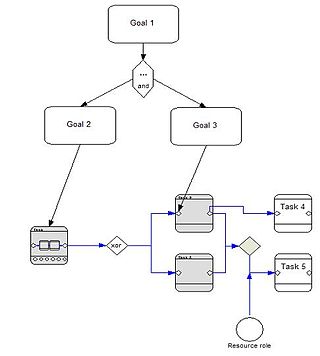In computing, a "virtual machine" (VM) is the virtualization or emulation of a computer system. Virtual machines are based on computer architectures and provide the functionality of a physical computer. Their implementations may involve specialized hardware, software, or a combination of the two. Virtual machines differ and are organized by their function, shown here:
In telecommunication, provisioning involves the process of preparing and equipping a network to allow it to provide new services to its users. In National Security/Emergency Preparedness telecommunications services, "provisioning" equates to "initiation" and includes altering the state of an existing priority service or capability.

Extended Enterprise Modeling Language (EEML) in software engineering is a modelling language used for Enterprise modelling across a number of layers.
In computing, thin provisioning involves using virtualization technology to give the appearance of having more physical resources than are actually available. If a system always has enough resource to simultaneously support all of the virtualized resources, then it is not thin provisioned. The term thin provisioning is applied to disk layer in this article, but could refer to an allocation scheme for any resource. For example, real memory in a computer is typically thin-provisioned to running tasks with some form of address translation technology doing the virtualization. Each task acts as if it has real memory allocated. The sum of the allocated virtual memory assigned to tasks typically exceeds the total of real memory.
A virtual appliance is a pre-configured virtual machine image, ready to run on a hypervisor; virtual appliances are a subset of the broader class of software appliances. Installation of a software appliance on a virtual machine and packaging that into an image creates a virtual appliance. Like software appliances, virtual appliances are intended to eliminate the installation, configuration and maintenance costs associated with running complex stacks of software.
Desktop virtualization is a software technology that separates the desktop environment and associated application software from the physical client device that is used to access it.

VMware ESXi is an enterprise-class, type-1 hypervisor developed by VMware for deploying and serving virtual computers. As a type-1 hypervisor, ESXi is not a software application that is installed on an operating system (OS); instead, it includes and integrates vital OS components, such as a kernel.
Hardware virtualization is the virtualization of computers as complete hardware platforms, certain logical abstractions of their componentry, or only the functionality required to run various operating systems. Virtualization hides the physical characteristics of a computing platform from the users, presenting instead an abstract computing platform. At its origins, the software that controlled virtualization was called a "control program", but the terms "hypervisor" or "virtual machine monitor" became preferred over time.

Puppet is a software configuration management tool which includes its own declarative language to describe system configuration. It is a model-driven solution that requires limited programming knowledge to use.
In computing, virtualization or virtualisation is the act of creating a virtual version of something at the same abstraction level, including virtual computer hardware platforms, storage devices, and computer network resources.

Cloud computing is the on-demand availability of computer system resources, especially data storage and computing power, without direct active management by the user. Large clouds often have functions distributed over multiple locations, each of which is a data center. Cloud computing relies on sharing of resources to achieve coherence and typically uses a pay-as-you-go model, which can help in reducing capital expenses but may also lead to unexpected operating expenses for users.
A hosted desktop is a product set within the larger cloud-computing sphere generally delivered using a combination of technologies including hardware virtualization and some form of remote connection software, Citrix XenApp or Microsoft Remote Desktop Services being two of the most common. Processing takes place within the provider's datacentre environment with traffic between the datacentre and the client being primarily display updates, mouse movements and keyboard activity.
HP Cloud Service Automation is cloud management software from Hewlett Packard Enterprise (HPE) that is used by companies and government agencies to automate the management of cloud-based IT-as-a-service, from order, to provision, and retirement. HP Cloud Service Automation orchestrates the provisioning and deployment of complex IT services such as of databases, middleware, and packaged applications. The software speeds deployment of application-based services across hybrid cloud delivery platforms and traditional IT environments.
IT chargeback and IT showback (memo-back) are two policies used by information technology (IT) departments to allocate and/or bill the costs associated with each department's or division's usage.
VM-aware storage (VAS) is computer data storage designed specifically for managing storage for virtual machines (VMs) within a data center. The goal is to provide storage that is simpler to use with functionality better suited for VMs compared with general-purpose storage. VM-aware storage allows storage to be managed as an integrated part of managing VMs rather than as logical unit numbers (LUNs) or volumes that are separately configured and managed.
openQRM is a free and open-source cloud-computing management platform for managing heterogeneous data centre infrastructures.
Software-defined storage (SDS) is a marketing term for computer data storage software for policy-based provisioning and management of data storage independent of the underlying hardware. Software-defined storage typically includes a form of storage virtualization to separate the storage hardware from the software that manages it. The software enabling a software-defined storage environment may also provide policy management for features such as data deduplication, replication, thin provisioning, snapshots and backup.

HP Cloud was a set of cloud computing services available from Hewlett-Packard that offered public cloud, private cloud, hybrid cloud, managed private cloud and other cloud services. It was the combination of the previous HP Converged Cloud business unit and HP Cloud Services, an OpenStack-based public cloud. It was marketed to enterprise organizations to combine public cloud services with internal IT resources to create hybrid clouds, or a mix of private and public cloud environments, from around 2011 until 2016.
Network functions virtualization (NFV) is a network architecture concept that leverages the IT virtualization technologies to virtualize entire classes of network node functions into building blocks that may connect, or chain together, to create and deliver communication services.
Cloud management is the management of cloud computing products and services.




